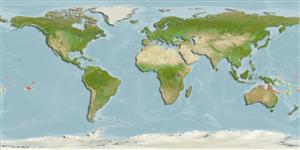>
Eupercaria/misc (Various families in series Eupercaria) >
Labridae (Wrasses) > Bodianinae
Etymology: Bodianus: Bodianus after Bodiano or Pudiano, from the Portuguese pudor, meaning modesty (Jordan & Evermann, 1896).; bennetti: Named for Timothy Bennett, the collector of the holotype of this new species..
Environment: milieu / climate zone / depth range / distribution range
Ecologia
marinhas associadas(os) a recifes; intervalo de profundidade 97 - 130 m (Ref. 82450). Tropical
Western Pacific: off the northeastern coast of Queensland (Coral Sea) and French Polynesia (Moorea)..
Tamanho / Peso / Idade
Maturity: Lm ? range ? - ? cm
Max length : 10.9 cm SL macho/indeterminado; (Ref. 82450)
Descrição suscinta
Morfologia | Morfometria
Espinhos dorsais (total): 12; Raios dorsais (total): 10; Espinhos anais 3; Raios anais : 12; Vértebras: 28. This species of the subgenus Trochocopus is distinguished by the following characters: pectoral-fin rays ii,15; lateral-line scales 42 + 2; scales above lateral line 4.5, scales below lateral line 13; predorsal scales 11; total gill rakers 12; shallow body its depth 25.0% SL; eye of moderate size with orbital diameter 7.0% SL; interorbital space narrow, 6.4% SL; caudal peduncle shallow, 13.2% SL; short posterior lobes on dorsal (11.1% SL) and anal (10.0% SL) fins; pectoral fin short, 18.0% SL; pelvic fin of moderate length, 16.1% SL, its tip reaching midway between fin origin and anus; posterior corner of mouth below anterior extent of orbit; upper jaw with length of first prominent anterior canine about equal length of second; dental ridge is smooth with regular series of granular teeth, single prominent canine at posterior end of jaw; lower jaw with first prominent anterior canine about half length of second; dental ridge with about 10 small erect canines increasing slightly in length from front to back, followed by about 8 shorter teeth; no vomerine teeth; pelvic fin short, tip reaching just beyond anus; body with 3 broad, red, lengthwise stripes separated by lemon-yellow or white stripes with lowermost red stripe not continuing anteriorly onto head, prominent black spot on middle red stripe on operculum behind eye and black pigmentation on membranes between first 3 or 4 dorsal-fin spines; juveniles have a prominent black spot at posterior end of middle red stripe on scaly caudal-fin base, which turns red in initial-phase adults and becomes more prominent in terminal-phase adults (Ref. 82450).
This species was observed on a gentle slope, over clean rubble, in a highcurrent area (Ref. 82450).
Ciclo de vida ou comportamento de acasalamento
Maturidade | Reprodução | Desova | Ovos | Fecundidade | Larvas
Gomon, M.F. and F. Walsh, 2016. A new pygmy hogfish (Labridae: Bodianus) of the subgenus Trochocopus from the tropical southern Pacific Ocean. J. Ocean Sci. Found. 23:12-20. (Ref. 82450)
Status na Lista Vermelha da UICN (Ref. 130435)
Ameaça para os humanos
Harmless
Uso pelos humanos
Mais informação
Nomes comunsSinônimosMetabolismoPredadoresEcotoxicologiaReproduçãoMaturidadeDesovaAgregação de desovaFecundidadeOvosDesenvolvimento dos ovos
Idade/TamanhoCrescimentoPeso-comprimentoComprimento-comprimentoFrequências de comprimentoMorfometriaMorfologiaLarvasDinâmica larvalRecrutamentoAbundânciaBRUVS
ReferênciasAquaculturaPerfil para aquaculturaEstirpesGenéticaElectrophoresesHereditariedadeDoençasProcessamentoNutrientsConversão de massa
ColaboradoresFotosStamps, Coins Misc.SonsCiguateraVelocidadeTipo de nataçãoÁrea branquialOtólitosCérebrosVisão
Ferramentas
Relatórios especiais
Baixar XML
Fontes da internet
Estimates based on models
Índice de diversidade filogenética (Ref.
82804): PD
50 = 0.5000 [Uniqueness, from 0.5 = low to 2.0 = high].
Bayesian length-weight: a=0.01202 (0.00551 - 0.02625), b=3.05 (2.87 - 3.23), in cm total length, based on LWR estimates for this Genus-body shape (Ref.
93245).
Nível Trófico (Ref.
69278): 3.3 ±0.5 se; based on size and trophs of closest relatives
Resiliência (Ref.
120179): Elevada, tempo mínimo de duplicação da população menor que 15 meses (Preliminary K or Fecundity.).
Fishing Vulnerability (Ref.
59153): Low vulnerability (10 of 100).
